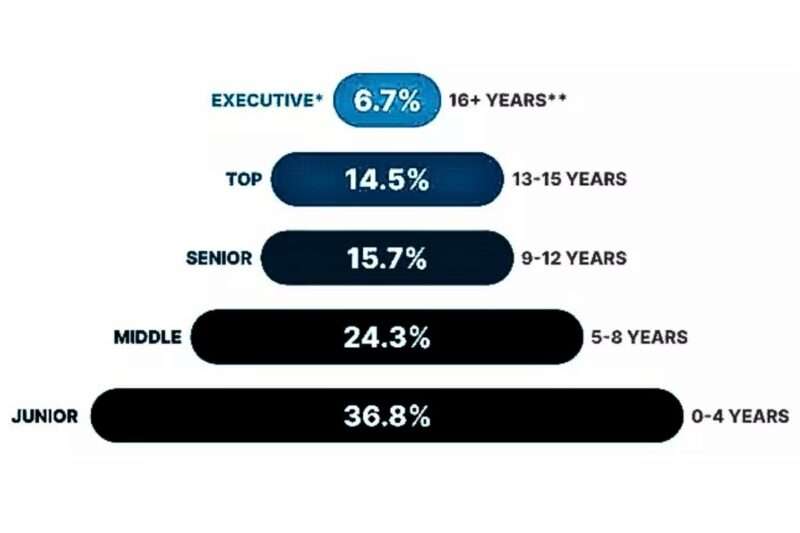Shifting Paradigms: Elevating The Case For Gender Diversity In Workplace.

A review of headcount data compiled by recruiting agency Xpheno revealed that five of India’s largest IT services businesses—Infosys, TCS, Wipro, LTI Mindtree, and HCL Tech—had a combined net departure of 25,000 women in the fiscal year ending March 31. Despite an increase in absolute numbers, the growth in the diversity ratio of these companies has slowed to minimal levels since the COVID-19 pandemic.
According to the diversity ratio, the overall number of women employed by this cohort increased from an expected 374,000 at the start of the pandemic (March 2020) to 540,000 in March 2023. Still, it declined to 515,000, ending the fiscal year 24.
While the number of women workers in these organisations climbed by around 141,000, or 38%, between 2020 and 2024, the diversity ratio in this cohort increased by only 0.9 percentage points during the same period, indicating a corresponding rise in male employee hiring. The average diversity ratio in the January-March 2024 quarter was 34.26%, down 0.6 percentage points from 34.32% the year before. Data revealed a larger 1.56 percentage point increase in diversity in the five IT organisations between 2018 and 2020, preceding the pandemic.
According to experts, the increase in women professionals in the workforce after the pandemic is mostly the result of an overall increase in hiring volume across genders rather than an increase in the diversity ratio.
How did Women in top management decline?
According to data supplied by Avtar group, a leading diversity, equity, and inclusion (DEI) solutions provider, there is a significant reduction in the number of women in leadership roles in the Indian IT industry- the diversity ratio at the senior level is 17%, which is less than half of the 35% at the entry-level. “This lack of advancement might be depressing for ambitious women,” said Saundarya Rajesh, founder and president of Avtar Group. “Imagine devoting yourself to a career only to encounter persistent roadblocks to growth and decent pay. Feeling underpaid and overlooked for promotions may be highly demotivating. “The pressure to achieve in a challenging area while also managing personal responsibilities leads to burnout, which results in high turnover.
According to Avtar statistics, women’s attrition in the IT sector is 26% higher than that across all industrial sectors, which is 21%.
Lack of gender diversity in deep tech.
Indian companies have struggled to attain gender diversity, and industries such as deep tech must take more measures to overcome it. The diversity at the junior levels is higher, at 37%. However, the diversity gap widens when people advance up the organisational hierarchy. It’s 6.7% at the executive level. In 31 deep tech industries, women comprise 26.5% at the junior level, 24.5% at the middle level, 19.2% at the senior level, 11.9% at the top level, and just 5.1% at the executive level.

- Personal goals, more education, a lack of mentoring, and marriage are among the causes of junior-level departures.
- Women employees at the mid-level face challenges due to caregiving duties, maternity, work-life balance, and professional growth limits.
- Health, gender prejudice, and a lack of leadership development opportunities, in addition to family and caregiving duties, pose challenges at the 9-12 year experience level.
- These are exacerbated at the executive level by the inclusion of unconscious pay disparities and life changes such as menopause.
Conversely, women can choose various job paths or entrepreneurial possibilities at any moment. However, recent data shows female founders earn 8X less than male founders, again a debate about these unconscious pay differences. In fiscal year 2023, male founders got a median salary of Rs 1.8 crore, while female founders earned Rs 1 crore. Unicorn firms’ lack of female directors is especially alarming in this context.
Part of this gap is also a lack of talent in a field that demands highly skilled abilities. Finding personnel aware of the most recent breakthroughs is much more challenging. According to the research, 43.9% of those surveyed believe deep tech expertise is tough to obtain, while 16.7% believe it is increasingly difficult to locate such talent.
Women in middle and senior management.
According to data from hiring agency Quess Corp, the proportion of women technologists in global capability centres (GCCs) has increased somewhat, hitting 30% in FY24, up from 26.6% in FY20. Despite this progress, there is still a significant difference in the presence of women in mid and senior-level jobs, resulting in a talent deficit in these areas.
According to a Pure Storage and Zinnov analysis, the number of women in executive roles in the GCCs is just 6.7%, showing a considerable drop in the available talent pool for women as they advance in their careers.
The female representation at the senior level, defined as having 9-12 years of experience, was reported to be 15.7%. India has almost 1,600 GCCs, with an addition of 2.8 lakh employees in 2022-23, bringing the entire skill base to more than 1.6 million. The research emphasises family and caregiving duties, restricted chances for professional growth and leadership, and difficulties with work-life balance as significant contributors to women’s attrition.

Vidya Munirathnam, HR head of Lowe’s India, cites the talent gap and the difficulties of upskilling following a maternity leave as one of the factors for women quitting the job. “When a woman returns from maternity leave, which typically lasts six months, she discovers that things have changed dramatically regarding technology. Most companies are experiencing a technological transition involving replacing outdated systems with more modern platforms. There is a skill gap, and it is sometimes simpler for them to resign rather than figure out how to upskill,” she added.
Lowe’s India’s proportion of women falls from 60% at the junior level to 28% at the vice-president level and higher. Similarly, at Thales India, women in senior management and higher roles account for fewer than 20%, despite the organisation’s total ratio of 31%. Despite introducing flexible HR policies like hybrid work, Sekhar Sahay, HR chief of Thales India, recognises the challenge of breaking global social conventions.
The good news is that women comprise 23.1% of the deep tech workforce, which is predicted to rise to 27.3% in five years. Zinnov’s report also looked at data on female engineering graduates from 42 top engineering universities that GCCs employ and 23 top colleges that deep tech firms hire between 2004 and 2023 in computer science, electronics, and communication fields. The findings reveal that fewer women graduate from these courses, but those who do outperform during placements.
What are the significant problems in gender disparity?
According to Pooja Sharma Goyal, CEO of The Udaiti Foundation, the elephant in the room is a structural obstacle in Indian workplaces that imposes an excessive responsibility of unpaid care work on Indian women. This hidden but significant economic contribution amounts to an astonishing 15-17% of the country’s GDP, highlighting the critical need to address this systemic imbalance. She emphasises that the gender pay gap is a continuous issue in India and throughout the world. This maintains economic inequity and impedes women’s development into leadership roles. Lack of flexibility and unfavourable work situations are vital reasons women leave.
Leaky pipelines of compliance in workplaces are another cause. “Despite rules such as the POSH (Prevention of Sexual Harassment) Act, there is a considerable gap in compliance with these standards, making it difficult to retain and advance female personnel. The Udaiti Foundation surveyed over 200 top HR professionals in Indian corporations, and more than 59% of respondents stated that their organisations had not established internal complaints committees stipulated by the POSH Act, underscoring the scale of the situation,” Sharma Goyal adds.
Women confront obstacles to job progression at all levels of the workplace. Naghma Mulla, CEO of the Edelgive Foundation, identifies these layers as social, institutional, and individual hurdles. In many circumstances, women have to quit their jobs or pass up opportunities that might further their careers. The leaking pipeline problem is quite significant in organisations. “A woman’s self-worth and confidence suffer when she lives in a biassed and generally apathetic environment. Alternatively, her sponsorship prospects are unfairly constrained,” Mulla claims.
The EdelGive Foundation’s 2023 research, A Study on Pathways to Leadership for Women in the Finance and Economic Sectors, identifies numerous more hurdles to women’s development in the workplace. There are preconceived views that a woman’s leadership style is less decisive or competent, making it difficult for her to be considered for top roles. Opportunities available to them are primarily in service duties rather than more aggressive sales.
So, are we still discussing the problems or some steps that have been taken and can be used as references to work more on gender diversity?
In recent years, initiatives designed to recruit and retain high-potential women in the technology field have increased. According to Avtar statistics, the goal to promote diversity, equality, and inclusion (DEI) has increased from 73% to 77% since the pandemic.
According to a recent survey by ANSR, a consulting firm, women in the IT industry face prejudice in various ways, including representation, decision-making, recognition, and opportunities. Krishna Vij, business head of Teamlease Digital, stated that “addressing the gender imbalance in senior roles is critical.” This may be accomplished by enacting policies that help women at critical life periods, such as providing flexible work arrangements, mentorship programmes, and supporting return-to-work efforts for individuals returning to the workforce after a professional break.”
Mulla says that no strategy or initiative to aid women in the workplace would be effective unless top management and male employees become active stakeholders. Senior leadership’s explicit goal of treating women similarly and providing equal opportunities as men sets the tone for a progressive work culture, which can help normalise gender-equitable practices. Furthermore, women will be unable to prosper in the job unless they receive help from their male counterparts in overcoming obstacles.
Paid parental leave is another critical policy companies must implement to guarantee that childcare responsibilities are balanced between parents. Companies must also strive for openness in pay grades. Some firms are assisting women in breaking down these barriers by launching initiatives with particular goals.

Dr. Reddy’s, for example, offers diversity-specific key performance areas for leadership. As a result, the firm now employs more women than the industry average. Dr. Reddy’s also employs alternate resourcing strategies such as bench hiring, which involves training and promoting certain women.
Sun Pharma’s Sunari-Women’s Peer Groups, Zydus’s WINGS Leadership Programme, and Lupin’s iMpact Women’s Mentoring Programme are examples of well-organized women-focused development programmes in the industry. Returnship schemes aim to bring women back into the workforce following a professional gap. They include an age relaxation for women who have taken breaks and particular training to help them transition back into the job.
Aditya Birla Fashion & Retail Ltd’s Springboard programme involves female employees engaging with female middle-management leaders to build self-awareness and insights into strengths, areas for development, management, and leadership styles. Participants in this course were able to develop their identities as successful managers and leaders.
Tech Mahindra’s flagship WLP-Crown (Creating Result-Oriented Women) pathway for women in middle management is a nine-month tailored learning plan designed to improve diversity ratios in leadership positions. Participants can also use tools like Harvard Spark to assist their learning.
Infosys’ Orbit Next is a year-long course for its female managers in India. It attempts to enhance capacities by reskilling and sharpening leadership skills to prepare individuals for higher-level responsibilities. Another is Restart with Infosys, a one-of-a-kind initiative that hires women who have taken professional interruptions. It provides flexible working arrangements, training, skill development, and intensive mentorship to give women the support and confidence they need to resume their professions.
Hopefully, more organisations will announce such policies to effect large-scale and structural changes in the workplace environment to promote women’s growth.
The bottom line.
According to Sharma Goyal, creating a genuinely empowering workplace for women requires a proactive plan for addressing structural barriers throughout the employee’s lifespan. “To address barriers to advancement, such as gender role segregation, firms must implement measures like re-onboarding programmes, more equitable promotion routes, and the elimination of gender disparities in middle management. Mentorship and sponsorship programmes and initiatives to combat preconceptions are critical at the leadership level for developing a pipeline of female talent. “By applying such focused initiatives, companies can create an atmosphere in which women flourish and drive organisational success with purpose,” she claims.
Every year on Women’s Day, several postings and articles highlight the pioneering ways of female achievers or criticise women’s poor labour force involvement in the economy. However, only policy changes will result in systemic environmental adjustments.




